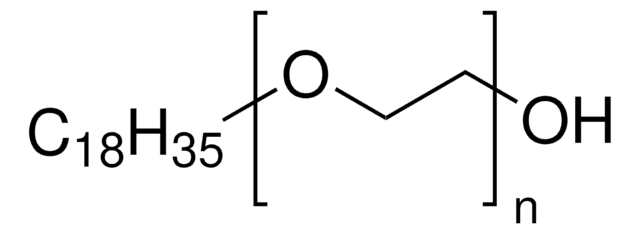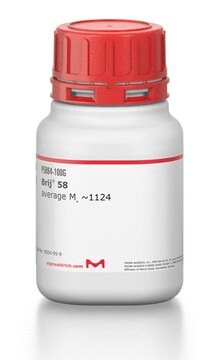Kluczowe dokumenty
STS0214
ECO BRIJ® O20
average Mn ~1,150
Synonim(y):
BRIJ® O20, Polyoxyethylene (20) oleyl ether
About This Item
Polecane produkty
opis
non-ionic
Poziom jakości
Formularz
solid
masa cząsteczkowa
average Mn ~1,150
charakterystyka ekologicznej alternatywy
Use of Renewable Feedstocks
Design for Degradation
Learn more about the Principles of Green Chemistry.
sustainability
Greener Alternative Product
mp
25-30 °C (lit.)
wartość hydroksylowa
50‑65 mg KOH/g
rozpuszczalność
water: soluble 1 g/L at 20 °C
gęstość
0.901 g/cm3 at 20 °C
HLB
15.5
kategoria ekologicznej alternatywy
ciąg SMILES
O(CCO)CCCCCCCC\C=C/CCCCCCCC
InChI
1S/C20H40O2/c1-2-3-4-5-6-7-8-9-10-11-12-13-14-15-16-17-19-22-20-18-21/h9-10,21H,2-8,11-20H2,1H3/b10-9-
Klucz InChI
KWVPFECTOKLOBL-KTKRTIGZSA-N
Szukasz podobnych produktów? Odwiedź Przewodnik dotyczący porównywania produktów
Opis ogólny
Cechy i korzyści
- 100 % Odnawialne
- 100% na bazie biologicznej
- Certyfikat zgodności z programem USDA BioPreferred
- Niższy ślad węglowy niż w przypadku wersji petrochemicznych
- Substancja chemiczna o wysokiej czystości odpowiednia do szerokiej gamy zastosowań badawczych
Inne uwagi
Informacje prawne
Hasło ostrzegawcze
Warning
Zwroty wskazujące rodzaj zagrożenia
Zwroty wskazujące środki ostrożności
Klasyfikacja zagrożeń
Aquatic Chronic 2 - Skin Irrit. 2
Kod klasy składowania
11 - Combustible Solids
Klasa zagrożenia wodnego (WGK)
WGK 1
Temperatura zapłonu (°F)
>464.0 °F - Equilibrium method
Temperatura zapłonu (°C)
> 240 °C - Equilibrium method
Wybierz jedną z najnowszych wersji:
Certyfikaty analizy (CoA)
It looks like we've run into a problem, but you can still download Certificates of Analysis from our Dokumenty section.
Proszę o kontakt, jeśli potrzebna jest pomoc Obsługa Klienta
Masz już ten produkt?
Dokumenty związane z niedawno zakupionymi produktami zostały zamieszczone w Bibliotece dokumentów.
Nasz zespół naukowców ma doświadczenie we wszystkich obszarach badań, w tym w naukach przyrodniczych, materiałoznawstwie, syntezie chemicznej, chromatografii, analityce i wielu innych dziedzinach.
Skontaktuj się z zespołem ds. pomocy technicznej




